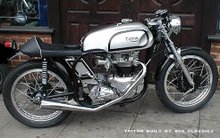Two weeks ago, while getting some parts that I will never use ready to sell on Ebay, I had an epiphany, a revelation on the direction to take this project. Up until now I had been planning on running a belt drive for the primary, and as a result I was going to have to buy a fancy rear wheel with an enclosed cush drive - about $500 dollars worth of kit. If you add that to the $800 dollars for the belt drive and I have thrown away a lot of dosh just so that I don't have to adjust the primary chain or worry about oil drips. Among the pile of parts was a complete AMC clutch that I had picked up in the early stages of planning parts, and then promptly forgotten about. With about $100 dollars of parts it will be better than new, and I can spend the rest of the saved money on other bits that will move the project beyond the pile of parts stage.
So with the primary figured out, it was time to sort out the rear hub so that I have something to align the gearbox to when I get there. The choice was either the original Norton rear hub or a Triumph conical hub, both of which I had among my parts pile in the shed. The Triumph hub is the better brake, lighter and looks like a Norton Manx racing unit. However, it isn't a Norton Manx racing unit but a later knock off and I am trying to keep this project as original as possible. So with that in mind, I decided to use the Norton hub - a full width alloy hub with cast iron drum bolted onto it. Looks nice but really heavy, and therein lies my weekend's work - trim down some weight and make it look a little less stock.
I had seen some pictures of a Velocette Thruxton with a scalloped hub and thought it would be a good look. So with some careful measurements, a calculator and remembering that π (pi) was about 3.141 I set about marking the hub up. It took me a while to get the technique down, starting with various files, grinder bits and then I came across a set of small sanding drums that were the right diameter for what I needed, slow going but the results looked good.
 The first side took the better half of Saturday, but I was more than a little chuffed at how it was looking. Not necessarily any lighter but very Mad Max. I decided to call it a day and do the other side on Sunday.
The first side took the better half of Saturday, but I was more than a little chuffed at how it was looking. Not necessarily any lighter but very Mad Max. I decided to call it a day and do the other side on Sunday. Sunday morning I return to the shed and mark up the remaining side. With it all pre-marked, and knowing now what I am doing it races along; enough so that my mind starts to wander and I am not really concentrating but thinking about the next job. Two scallops left and..... BOLLOCKS!!! I misread my own marks and sand the wrong bit - right over the spoke hole leaving so little metal that the strength is going to be more than a bit suspect.
Sunday morning I return to the shed and mark up the remaining side. With it all pre-marked, and knowing now what I am doing it races along; enough so that my mind starts to wander and I am not really concentrating but thinking about the next job. Two scallops left and..... BOLLOCKS!!! I misread my own marks and sand the wrong bit - right over the spoke hole leaving so little metal that the strength is going to be more than a bit suspect. I decide to finish it off anyway and give it a clean and try and figure out if it is repairable with some clever welding. When all was done I was even more mad at myself because it really did look good and painted up it would have looked even better.
I decide to finish it off anyway and give it a clean and try and figure out if it is repairable with some clever welding. When all was done I was even more mad at myself because it really did look good and painted up it would have looked even better.  I decide to set it aside and mull over my options and have a beer to refresh my soul and well being. Second beer in and I start to like the looks of that conical hub a little more. After all, it is the better hub and it is a lot cleaner a design. You can also change the sprocket without replacing the whole drum, which I needed to do with the Norton hub, and they don't come cheep. The hub I have on hand has a brand new alloy sprocket and new break shoes - I can fix this up without being anymore out of pocket.
I decide to set it aside and mull over my options and have a beer to refresh my soul and well being. Second beer in and I start to like the looks of that conical hub a little more. After all, it is the better hub and it is a lot cleaner a design. You can also change the sprocket without replacing the whole drum, which I needed to do with the Norton hub, and they don't come cheep. The hub I have on hand has a brand new alloy sprocket and new break shoes - I can fix this up without being anymore out of pocket.So with another new direction decided, it was time to break out the hole saw and attack the next hub. Two inch holes fit nicely between the stiffening ribs and don't affect the strength of the hub. So once again, with some careful measurements, a calculator and remembering that π (pi) was about 3.141 I set about marking the hub up. Happy that I had the marks all equidistant and where they were meant to be, I put the hole saw in my drill press and started making holes.
 The first hole went without to much trouble other than a lot of vibration. I started in on the second hole and the chuck on my drill press decided to disintegrate throwing bearing around the shed and leaving the drill inoperative. Just not a good weekend. Refusing to be beaten, I pull out my trusty old hand drill and attack the hub to finish it off.
The first hole went without to much trouble other than a lot of vibration. I started in on the second hole and the chuck on my drill press decided to disintegrate throwing bearing around the shed and leaving the drill inoperative. Just not a good weekend. Refusing to be beaten, I pull out my trusty old hand drill and attack the hub to finish it off. After all five holes are drilled, it is time to smooth them out and remove all the sharp edges that will encourage stress fractures to start. A good clean up later and I am pretty pleased with the results and I think it will look good on the bike. I am tempted to scallop this hub too, but after the last unmitigated disaster I am thinking I might just leave it as is.
After all five holes are drilled, it is time to smooth them out and remove all the sharp edges that will encourage stress fractures to start. A good clean up later and I am pretty pleased with the results and I think it will look good on the bike. I am tempted to scallop this hub too, but after the last unmitigated disaster I am thinking I might just leave it as is.
 The next job is to powdercoat it black and fit gauze in the holes to stop rocks, birds, small children and the like from falling in and jamming the brakes. But that can wait until I am ready to get it laced to a rim.
The next job is to powdercoat it black and fit gauze in the holes to stop rocks, birds, small children and the like from falling in and jamming the brakes. But that can wait until I am ready to get it laced to a rim. And if I change my mind again, it really will make a lovely lampshade.
And if I change my mind again, it really will make a lovely lampshade.











